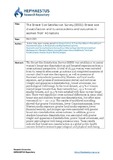The Breast Size Satisfaction Survey (BSSS): Breast size dissatisfaction and its antecedents and outcomes in women from 40 nations
| dc.contributor.author | Swami, Viren | |
| dc.contributor.author | Tran, Ulrich S. | |
| dc.contributor.author | Barron, David | |
| dc.contributor.author | Afhami, Reza | |
| dc.contributor.author | Aime, Annie | |
| dc.contributor.author | Almenara, Carlos A. | |
| dc.contributor.author | Alp Dal, Nursel | |
| dc.contributor.author | Soares Amaral, Ana Carolina | |
| dc.contributor.author | Andrianto, Sonny | |
| dc.contributor.author | Anjum, Gulnaz | |
| dc.contributor.author | Argyrides, Marios | |
| dc.contributor.author | Atari, Mohammad | |
| dc.contributor.author | Aziz, Mudassar | |
| dc.contributor.author | Banai, Benjamin | |
| dc.contributor.author | Borowiec, Joanna | |
| dc.contributor.author | Brewis, Alexandra | |
| dc.contributor.author | Kocak, Yeliz Cakir | |
| dc.contributor.author | Alvares Duarte Bonini Campos, Juliana | |
| dc.contributor.author | Voracek, Martin | |
| dc.date.accessioned | 2021-02-22T09:11:29Z | |
| dc.date.available | 2021-02-22T09:11:29Z | |
| dc.date.issued | 2020-03 | |
| dc.identifier.uri | http://hdl.handle.net/11728/11687 | |
| dc.description.abstract | The Breast Size Satisfaction Survey (BSSS) was established to assess women’s breast size dissatisfaction and breasted experiences from a cross-national perspective. A total of 18,541 women were recruited from 61 research sites across 40 nations and completed measures of current-ideal breast size discrepancy, as well as measures of theorised antecedents (personality, Western and local media exposure, and proxies of socioeconomic status) and outcomes (weight and appearance dissatisfaction, breast awareness, and psychological well-being). In the total dataset, 47.5 % of women wanted larger breasts than they currently had, 23.2 % wanted smaller breasts, and 29.3 % were satisfied with their current breast size. There were significant cross-national differences in mean ideal breast size and absolute breast size dissatisfaction, but effect sizes were small (η2 = .02–.03). The results of multilevel modelling showed that greater Neuroticism, lower Conscientiousness, lower Western media exposure, greater local media exposure, lower financial security, and younger age were associated with greater breast size dissatisfaction across nations. In addition, greater absolute breast size dissatisfaction was associated with greater weight and appearance dissatisfaction, poorer breast awareness, and poorer psychological well-being across nations. These results indicate that breast size dissatisfaction is a global public health concern linked to women’s psychological and physical well-being. | en_UK |
| dc.language.iso | en | en_UK |
| dc.publisher | Body image | en_UK |
| dc.rights | © 2020 Elsevier Ltd. | en_UK |
| dc.rights.uri | http://creativecommons.org/licenses/by-nc-nd/4.0/ | en_UK |
| dc.subject | Breast size | en_UK |
| dc.subject | Breast ideals | en_UK |
| dc.subject | Breast awareness | en_UK |
| dc.subject | Personality | en_UK |
| dc.subject | Psychological well-being | en_UK |
| dc.subject | Cross-cultural psychology | en_UK |
| dc.title | The Breast Size Satisfaction Survey (BSSS): Breast size dissatisfaction and its antecedents and outcomes in women from 40 nations | en_UK |
| dc.type | Article | en_UK |
| dc.doi | https://doi.org/10.1016/j.bodyim.2020.01.006 | en_UK |
Files in this item
This item appears in the following Collection(s)
-
Articles377
Άρθρα


